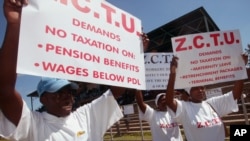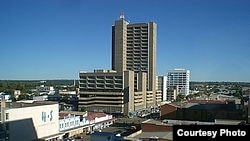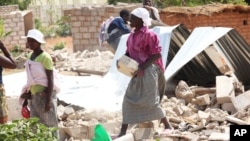WASHINGTON DC —
The Zimbabwe National Statistics Agency (Zimstats) says the country has an unemployment rate of 10.7 percent, a figure which has been dismissed as grossly misleading by the Zimbabwe Congress of Trade Unions and some economists.
Indications are that over 6,000 workers lost their jobs last year alone due to company closures and retrenchments. This has now become the order of the day in a nation where 8.2 million people are classified by Zimstats as poor.
A Zimstats survey conducted between 2011 and 2012 involving over 6 million respondents showed that Zimbabwe’s unemployment rate was lower than the 90 percent which was usually touted by local labor unions.
According to the government agency, tasked with conducting important national surveys, Zimbabwe has an unemployment rate of 10.7 percent. A recent survey has come up with similar findings in a nation where 8.2 million Zimbabweans, mostly in rural areas, are believed to be poor.
Community leaders say the high poverty levels in cities and rural areas have seriously affected many families who are struggling to make a decent living.
Bulawayo Mayor Patrick Thaba Moyo says more than 500,000 city dwellers are now classified as poor.
He said: “The economy has not been doing well in the country and as Bulawayo you know that 8% of our people are in the formal sector. We are proud that as Bulawayo we have come in to try and provide space so that they can informally trade.
“But companies are closing and as they close people are out of employment and if they are out of employment they can’t have food, they can’t have clothes, they can’t send children to school, they can’t have medical attention … People have become poor.”
The city says it has 1,000 000 residents though Zimstats insists that there are only 656,000 Bulawayo inhabitants.
Mr. Moyo says among the poor are some people who used to be bread winners who lost their jobs after they were either retrenched or sent home when companies shut down due to lack of money to revamp operations.
“It’s not only about Bulawayo, it’s a national problem. Our children fail to pay their school fees, our people fail to pay rentals and other things. … I believe at the moment (that poverty) should be above 50%. People are failing to pay service providers like the city council, ZESA, TelOne and so forth,” said Mr. Moyo.
The Matabeleland Chamber of Industries and other stakeholders, believe that over 90 firms shut down in the city between 2009 and 2012, leaving more than 23,000 people jobless. The mayor says this is a recipe for disaster.
His views are echoed by Councillor Peter Moyo of Harare City Council’s Ward 13, who adds that more than 1.8 million people who live in the city are poor.
Mr. Moyo says: The level of poverty in Zimbabwe is very alarming because 95% of the population is unemployed. So, having such a situation is becoming horrible. Where does the government get its money from because most governments survive on taxes? But if 95% of the population is not working (formally), then how do we expect a country to move?
"They are busy selling vegetables, fish and other goods. That is why sometimes we have an outbreak of cholera and typhoid because people are just doing something for survival and not looking at their own health. They sell anything,” he said.
The councillor says the poor have resorted to many ways of eking out a living including corrupt activities. He says almost 8 out of 10 working-age residents are now in the informal sector.
The councillor further argues that those that have remained in the formal sector are living far below the breadline. He says some are being paid as low as $50 a month.
“The person in the informal sector is better off than someone working in the formal sector. Right now people are getting their salaries in batches. If you earn $400 per month, it means you are going to be paid $50 per week. What do you do with $50? The landlord will at the same time be demanding something like $200 (per month),” said Councillor Moyo.
The situation is pathetic in most sectors of the economy, including the clothing industry that has almost collapsed.
Kezlina Ndlovu, deputy secretary of the National Union of the Clothing Industry, says their membership has been seriously affected by company closures.
Mrs. Ndlovu said: “Prices of basic commodities have been going up … And then members will say it’s better for me to take that $5 and use it for buying bread instead of membership fees. They are withdrawing everyday and the fact is that we are losing members everyday. I will be surprised if at all we have 3,000 members left in our books.”
She says job losses have forced most people to live on less than a dollar per day.
Her union used to have about 10,000 workers but now has less than 3,000 subscribers, a situation which has also forced union workers to struggle for survival.
She says the situation has been worsened by the availability of cheap Chinese goods being sold in most urban areas.
“The problems we have now are just because of these cheap things, very cheap products selling for $1 for two items. When someone is sewing something in a factory, you cannot sell anything for a dollar because we import some of the material. After sewing any commodity, one cannot sell it for any price below $10. But these things that come from the Chinese are a dollar. So, people do not even buy from factories anymore.”
In some provinces like Matabeleland North with poverty gripping over 639,000 out of 780,000 inhabitants, the future looks bleak for local workers.
Critics say only elections can lead to the creation of a better socio-economic and political environment for revamping industries and the generation of jobs in the country.
Indications are that over 6,000 workers lost their jobs last year alone due to company closures and retrenchments. This has now become the order of the day in a nation where 8.2 million people are classified by Zimstats as poor.
A Zimstats survey conducted between 2011 and 2012 involving over 6 million respondents showed that Zimbabwe’s unemployment rate was lower than the 90 percent which was usually touted by local labor unions.
According to the government agency, tasked with conducting important national surveys, Zimbabwe has an unemployment rate of 10.7 percent. A recent survey has come up with similar findings in a nation where 8.2 million Zimbabweans, mostly in rural areas, are believed to be poor.
Community leaders say the high poverty levels in cities and rural areas have seriously affected many families who are struggling to make a decent living.
Bulawayo Mayor Patrick Thaba Moyo says more than 500,000 city dwellers are now classified as poor.
He said: “The economy has not been doing well in the country and as Bulawayo you know that 8% of our people are in the formal sector. We are proud that as Bulawayo we have come in to try and provide space so that they can informally trade.
“But companies are closing and as they close people are out of employment and if they are out of employment they can’t have food, they can’t have clothes, they can’t send children to school, they can’t have medical attention … People have become poor.”
The city says it has 1,000 000 residents though Zimstats insists that there are only 656,000 Bulawayo inhabitants.
Mr. Moyo says among the poor are some people who used to be bread winners who lost their jobs after they were either retrenched or sent home when companies shut down due to lack of money to revamp operations.
“It’s not only about Bulawayo, it’s a national problem. Our children fail to pay their school fees, our people fail to pay rentals and other things. … I believe at the moment (that poverty) should be above 50%. People are failing to pay service providers like the city council, ZESA, TelOne and so forth,” said Mr. Moyo.
The Matabeleland Chamber of Industries and other stakeholders, believe that over 90 firms shut down in the city between 2009 and 2012, leaving more than 23,000 people jobless. The mayor says this is a recipe for disaster.
His views are echoed by Councillor Peter Moyo of Harare City Council’s Ward 13, who adds that more than 1.8 million people who live in the city are poor.
Mr. Moyo says: The level of poverty in Zimbabwe is very alarming because 95% of the population is unemployed. So, having such a situation is becoming horrible. Where does the government get its money from because most governments survive on taxes? But if 95% of the population is not working (formally), then how do we expect a country to move?
"They are busy selling vegetables, fish and other goods. That is why sometimes we have an outbreak of cholera and typhoid because people are just doing something for survival and not looking at their own health. They sell anything,” he said.
The councillor says the poor have resorted to many ways of eking out a living including corrupt activities. He says almost 8 out of 10 working-age residents are now in the informal sector.
The councillor further argues that those that have remained in the formal sector are living far below the breadline. He says some are being paid as low as $50 a month.
“The person in the informal sector is better off than someone working in the formal sector. Right now people are getting their salaries in batches. If you earn $400 per month, it means you are going to be paid $50 per week. What do you do with $50? The landlord will at the same time be demanding something like $200 (per month),” said Councillor Moyo.
The situation is pathetic in most sectors of the economy, including the clothing industry that has almost collapsed.
Kezlina Ndlovu, deputy secretary of the National Union of the Clothing Industry, says their membership has been seriously affected by company closures.
Mrs. Ndlovu said: “Prices of basic commodities have been going up … And then members will say it’s better for me to take that $5 and use it for buying bread instead of membership fees. They are withdrawing everyday and the fact is that we are losing members everyday. I will be surprised if at all we have 3,000 members left in our books.”
She says job losses have forced most people to live on less than a dollar per day.
Her union used to have about 10,000 workers but now has less than 3,000 subscribers, a situation which has also forced union workers to struggle for survival.
She says the situation has been worsened by the availability of cheap Chinese goods being sold in most urban areas.
“The problems we have now are just because of these cheap things, very cheap products selling for $1 for two items. When someone is sewing something in a factory, you cannot sell anything for a dollar because we import some of the material. After sewing any commodity, one cannot sell it for any price below $10. But these things that come from the Chinese are a dollar. So, people do not even buy from factories anymore.”
In some provinces like Matabeleland North with poverty gripping over 639,000 out of 780,000 inhabitants, the future looks bleak for local workers.
Critics say only elections can lead to the creation of a better socio-economic and political environment for revamping industries and the generation of jobs in the country.







